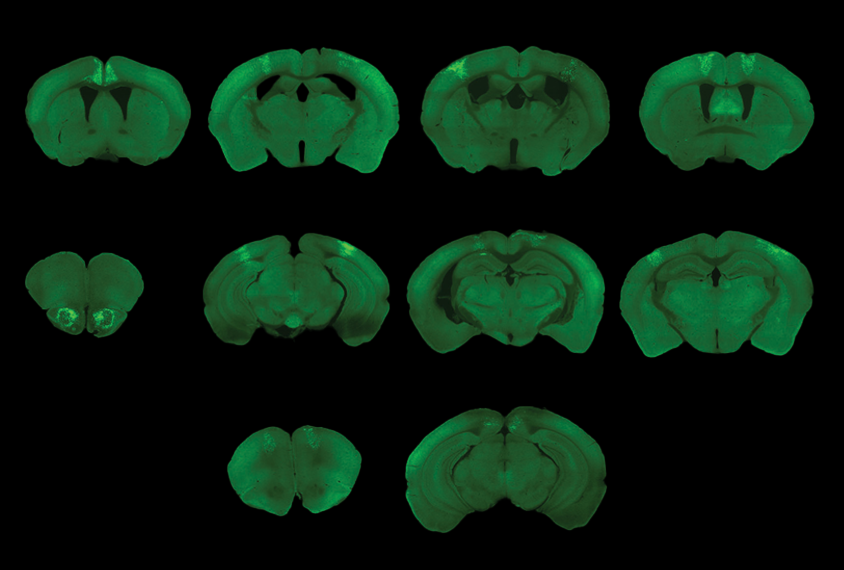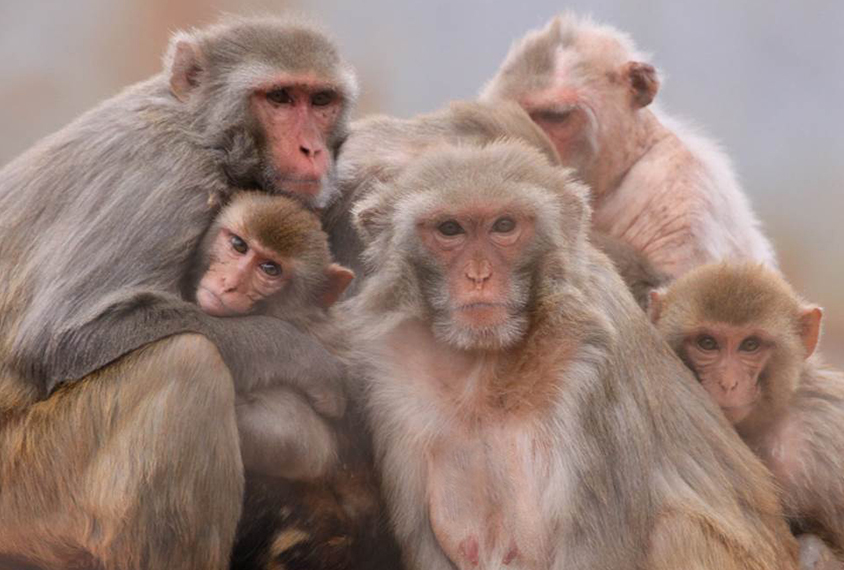SHANK2
Double SHANK knockout highlights brain circuit’s social role
Mice missing the autism-linked SHANK2 and SHANK3 genes in their retrosplenial cortex have trouble distinguishing between novel and familiar mice.

Double SHANK knockout highlights brain circuit’s social role
Mice missing the autism-linked SHANK2 and SHANK3 genes in their retrosplenial cortex have trouble distinguishing between novel and familiar mice.
Macaques’ social skills tied to variation in autism-linked genes
Genetics strongly influences some aspects of the monkey’s social behavior, including tendencies to solicit grooming and sit or play alone.

Macaques’ social skills tied to variation in autism-linked genes
Genetics strongly influences some aspects of the monkey’s social behavior, including tendencies to solicit grooming and sit or play alone.
How microscopic ‘condensates’ in cells might contribute to autism
A controversial idea about how cells compartmentalize their contents into droplets — like beads of oil in water — could be key to understanding autism, says Julie Forman-Kay.

How microscopic ‘condensates’ in cells might contribute to autism
A controversial idea about how cells compartmentalize their contents into droplets — like beads of oil in water — could be key to understanding autism, says Julie Forman-Kay.
Mechanical tracker measures social activity of multiple mice for days
A new system enables researchers to automatically track the social behavior of up to four mice for days at a time.
Mechanical tracker measures social activity of multiple mice for days
A new system enables researchers to automatically track the social behavior of up to four mice for days at a time.
New method creates uniform cultures of lab-grown neurons
A new technique leads to neuron cultures of consistent quality, enabling scientists to study how autism mutations alter neurons.

New method creates uniform cultures of lab-grown neurons
A new technique leads to neuron cultures of consistent quality, enabling scientists to study how autism mutations alter neurons.
Rats with mutant SHANK genes show autism-like behaviors
Researchers have engineered two new rats with mutations in a family of genes that function at neuronal junctions, they reported today at the 2014 International Meeting for Autism Research in Atlanta.

Rats with mutant SHANK genes show autism-like behaviors
Researchers have engineered two new rats with mutations in a family of genes that function at neuronal junctions, they reported today at the 2014 International Meeting for Autism Research in Atlanta.
Neighboring mutations in gene may spawn separate conditions
Two seemingly similar mutations in the SHANK3 gene have divergent effects on the brain and behavior.

Neighboring mutations in gene may spawn separate conditions
Two seemingly similar mutations in the SHANK3 gene have divergent effects on the brain and behavior.
Small snippets of genes may have big effects in autism
Small pieces of DNA within genes, dubbed ‘microexons,’ are abnormally regulated in people with autism, suggests a study of postmortem brains.

Small snippets of genes may have big effects in autism
Small pieces of DNA within genes, dubbed ‘microexons,’ are abnormally regulated in people with autism, suggests a study of postmortem brains.
Family of autism-linked proteins helps neurons communicate
The SHANK family of proteins, some of which are strong autism candidates, work together to facilitate brain signaling, according to unpublished results presented yesterday at the 2014 Society for Neuroscience annual meeting in Washington, D.C.

Family of autism-linked proteins helps neurons communicate
The SHANK family of proteins, some of which are strong autism candidates, work together to facilitate brain signaling, according to unpublished results presented yesterday at the 2014 Society for Neuroscience annual meeting in Washington, D.C.
SHANK3 mutations turn up in high proportion of autism cases
About 2 percent of people who have both autism and intellectual disability carry harmful mutations in SHANK3, a protein that helps organize the connections between neurons, according to a study published 4 September in PLoS Genetics.

SHANK3 mutations turn up in high proportion of autism cases
About 2 percent of people who have both autism and intellectual disability carry harmful mutations in SHANK3, a protein that helps organize the connections between neurons, according to a study published 4 September in PLoS Genetics.
Explore more from The Transmitter
New connectomes fly beyond the brain
Researchers are mapping the neurons in Drosophila’s ventral nerve cord, where the central nervous system meets the rest of the body.

New connectomes fly beyond the brain
Researchers are mapping the neurons in Drosophila’s ventral nerve cord, where the central nervous system meets the rest of the body.
Building an autism research registry: Q&A with Tony Charman
A purpose-built database of participants who have shared genomic and behavioral data could give clinical trials a boost, Charman says.

Building an autism research registry: Q&A with Tony Charman
A purpose-built database of participants who have shared genomic and behavioral data could give clinical trials a boost, Charman says.
Cerebellar circuit may convert expected pain relief into real thing
The newly identified circuit taps into the brain’s opioid system to provide a top-down form of pain relief.

Cerebellar circuit may convert expected pain relief into real thing
The newly identified circuit taps into the brain’s opioid system to provide a top-down form of pain relief.